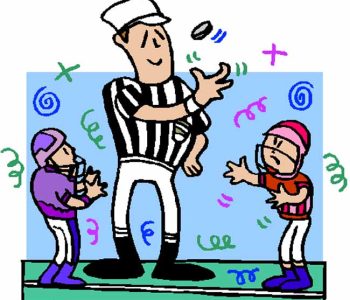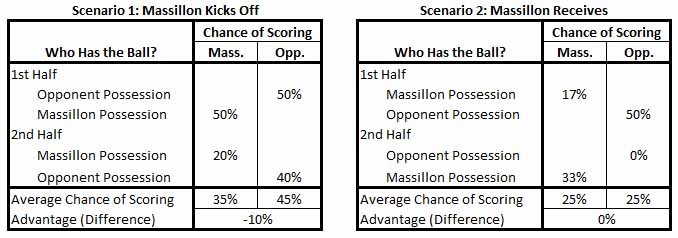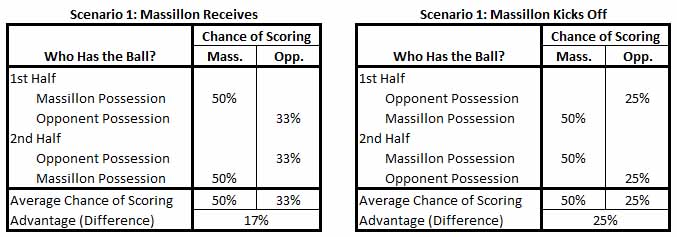 Editorial
Editorial Is Deferring to the Second Half the Correct Strategy?
Is Deferring to the Second Half the Correct Strategy?
We’ve seen it often enough. The co-captains of the two opponents meet at the center of the field to determine which one kicks off and which one receives the ball to start the game. The visiting team calls the toss. The referee flings the coin into the air and identifies the winner, which then has a choice to make. They either elect to receive the kick or defer until the second half. Invariably, they elect to defer. The loser of the toss is then left with one option: receive the ball. For, choosing to kick off would most likely result in also kicking off in the second half as well and thereby forfeiting a possession. The winner of the toss then selects the end of the field from which it will kick and the game begins. It’s a rare day when the winner of the toss chooses to receive the opening kickoff. But is deferring really the optimum strategy?
Background
In earlier days of football the winner of the coin toss had a choice of either receiving the ball or defending a particular end of the field. But this changed in 2008 when the NFL introduced the option for a team to defer their decision until the second half. College and high school, of course, followed suit shortly thereafter.
Both options, receiving and deferring, have inherent advantages. A team that receives the kick to start the game has an opportunity to score first. Once on top, that team can then stay with their planned offense, as long as the score remains in their favor. And, historically, a team that scores first wins the game about two-thirds of the time.
Conversely, a team that defers and kicks off subsequently starts the second half by receiving the ball. This strategy provides the potential to open the scoring gap if they are ahead or close the gap if behind. They might also receive an extra possession if they are the last team with the ball at the end of the game. It could also be a psychological ploy to intimidate the opponent if they have an overwhelming defense. Finally, there is the possibility of going back-to-back with scores if they tally right at the end of the first half and then again on their first possession of the second half.
Analysis
But let’s go back to the original question: is deferring to the second half the right strategy? Granted, the first two possessions of each half comprise a small segment of the overall game. But any advantage that can be gained in defeating the great teams is certainly worthy of consideration. To answer this question, a detailed analysis was performed, focusing specifically on Massillon and its game data from the last six seasons.
The study encompasses 84 games, but focuses specifically on those against the better opponents, since little trending knowledge can be gained from the games that were more one-sided, where the Tigers scored almost every time they had the ball. So, it focuses primarily on two groups of opponents:
- 16 great teams where Massillon was either evenly matched or considered an underdog. This group includes the larger parochial schools and those public schools they faced deep in the playoffs. The Tigers’ record against those teams was 6-10.
- 38 good teams where Massillon was considered a favorite, but not by a large margin. This group includes mid-sized parochial schools and those public schools that qualified for the playoffs, excluding a few mismatches. The Tigers’ record against those teams was 35-3.
Data was collected for both Massillon and its opponents, for each one’s initial possession of each half, regardless of whether they kicked off or received the ball to start the half. So, if Massillon kicked off to start the first half then they would have the second possession of the first half. Then in the second half, they would receive the kickoff and have the first possession. The opponent, of course, would have the opposite situation. The remaining game possessions following these first two are not considered relevant to the study and were not charted.
The data was then analyzed to determine whether it was advisable to either kick off or receive to open the game, while considering the combined effects of both Massillon and its opponents. In other words, the analysis searched for the situation where Massillon was maximizing its scoring potential, while at the same time minimizing the opponent’s scoring potential.
Results – vs. Great Teams
The charts below depict the chances of scoring for Massillon and the opponent based on the data compiled over the past six years relative to the 16 great teams. Two scenarios are displayed, the first if Massillon defers the decision and kicks off to start the game and the second if the other team defers and Massillon receives. For each scenario, the possessions are shown in the order in which they would occur during the game. In other words, if Massillon kicks off in the first half, then the opponent would receive the kick and have the first possession. In the second half, the opposite would occur.

In order to consider the effect of both Massillon’s and the opponent’s results, the average chances of a team scoring in either half are calculated and then the difference is taken between the two numbers. If the difference is positive, then Massillon has the advantage; if negative, then the advantage goes to the opponent.
Per the chart, since the overall advantage is negative when Massillon kicks off but zero when receiving, then the favorable decision would be to receive the ball to start the game. That would set the opponent up for a difficult first possession in the second half, where historically they have failed to score.
If Massillon desired to play the odds and follow this recommendation they fortunately would be nearly in full control of this decision. That’s because (1) they could elect to receive the ball if they won the toss, and (2) obviously receive the ball if the opponent won the toss and elected to defer, which it nearly always does.
Side note: In most cases, a team with a second possession of the half has a higher chance of scoring than with a first possession. One could argue that field position may be better with a second possession, since the team would often be receiving a punt, rather than starting deep in its own end following a kickoff. But the difference in starting field position within these 16 games turned out to not be significant enough (around five yards) to influence the results. But the key factor might just be, at least for the second half, that the players need some time to return to game mode following a grueling half of football followed by decompression in the locker room. Perhaps teams need to alter their routine after returning to the field, such as running a few simulated plays rather than focusing exclusively on stretching.
Results vs. Good Teams
The charts below depict the chances of scoring for Massillon and the opponent based on the data compiled over the past six years relative to the 36 good teams.

The Massillon advantage is positive in both scenarios, but favors Massillon kicking off to start the game. Therefore, it would make sense for Massillon to defer to the second half if they win the toss.
Summary
The analysis attempts to determine whether it is better to receive the ball or defer the decision to the second half following the pre-game coin toss. Six years of data encompassing 84 games were considered, with the opponents broken down into four categories.
- Great teams – 16 teams where Massillon is at even odds or an underdog to win. Preferable for Massillon to receive the opening kickoff, thereby forcing the opponent to receive the second half kickoff, from which they have produced zero scores.
- Good teams – 38 teams where Massillon is a moderate favorite to win. Slight advantage for Massillon to kick off to start the game.
- Average to below average teams – 30 teams where Massillon is a clear favorite to win. Kick or receive? It doesn’t matter.
It should be noted that this same analysis was performed on Ohio State against against several of their great opponents and a similar result was obtained.